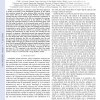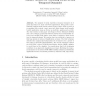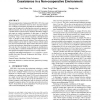130 search results - page 15 / 26 » Autonomous Units to Model Games |
ICC
2009
IEEE
14 years 2 months ago
2009
IEEE
— In this paper, we propose a game theoretical approach to tackle the problem of the distributed formation of the uplink tree structure among the relay stations (RSs) and their s...
ICCV
2007
IEEE
13 years 9 months ago
2007
IEEE
The analysis of facial expression temporal dynamics is of great importance for many real-world applications. Being able to automatically analyse facial muscle actions (Action Units...
GLOBECOM
2010
IEEE
13 years 5 months ago
2010
IEEE
In current peer-to-peer file sharing networks, a large number of peers with heterogeneous connections simultaneously seek to download resources, e.g., files or file fragments, from...
VW
1998
Springer
13 years 11 months ago
1998
Springer
Abstract. This paper presents Webots: a realistic mobile robot simulator allowing a straightforward transfer to real robots. The simulator currently support the Khepera mobile robo...
MSWIM
2009
ACM
14 years 2 months ago
2009
ACM
The increasing number of independent IEEE 802.11 WLANs owned and managed by autonomous users has led to increased interference, resulting in performance degradation and unfairness...



